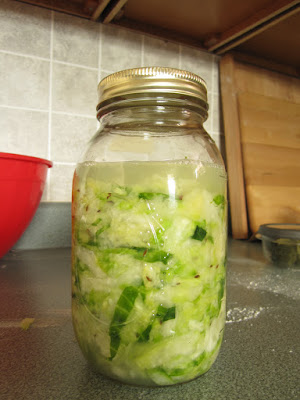| I don't know about you, but I love sauerkraut. I can eat it just by itself. |
I was lucky enough to attend the Farm to Table Conference here in Pittsburgh. It is an awesome little conference where local farms and health conscious businesses come to share about their products. There were also speakers, demonstrations and kids activities. One company that was there was Zukay Live Foods. They are a PA company that specializes in non-dairy probiotic foods. They have juices, salsa, salad dressings and relishes, all of which are made with fermented vegetables.
Why Fermented Vegetables Are Important
 |
| Don't say anything about her, she is AWESOME! |
These good bacteria can also be killed in our body by taking things like anti-biotics. Do I think you should not take these if your doctor prescribes them? No, but maybe up your fermented foods or yogurt intake afterwards to get all the good germs back.
Why it is important to eat RAW Fermented Foods
When you buy sauerkraut in the store it has been canned. This means that it has been cooked. When it's cooked all of the good bacteria has been fried alive! It no longer has the added help of the bacteria, it's just some tasty cabbage. When you ferment raw vegetables, you are keeping those bacteria alive and allowing them to prosper by breaking down the vegetables.We were lucky enough to see a demonstration by Scott Grzybek of Zukay, who made two fermented recipes in front of us. They were so easy that I decided to share them with you this week. It's a TWO-FER!
Sauerkraut AKA deliciousness in a bottle
Tools
Knife
Ball or other type of jar
Bowl
Masher
Ingredients
Celtic Sea Salt (please read note)
Cabbage
Spring Water (please read note)
Fennel/Caraway seeds, optional
1. Do not wash your cabbage! You want all of that added goodness on there, this is why I bought organic as to ensure it was all good stuff and not chemicals. Remove the large outer leaves that are almost falling off3.Slice the cabbage as thin as you would like your sauerkraut.
2. Throw the sliced cabbage into the bowl and add salt. Scott said to add a few teaspoons, but looked like he was adding a few Tablespoons. He was my kind of guy with the non-measurement thing, but I added about two teaspoons to mine and it was doing fine.
3. If you have the time let the sauerkraut sit in the salt.
| |
| See the water pooling on the bottom |
4. Once the cabbage is looking significantly beat. You can start stuffing it into your jar. Having a jar with a wide mouth really helps at this point. You want to squish out as much air as possible, so a small head of cabbage might not even fill your jar depending on what size it is. Just keep compacting and pushing the cabbage down, leaving no spaces or gaps. I also used a small ladle at this point because by hand couldn't reach the cabbage until it was much higher. The ladle really helped push it down.
5. When you feel confident that the cabbage can't possibly get anymore compact, look at the liquid level. If all of your cabbage isn't covered, this is where you need to add the spring water. Add enough to cover the cabbage, anything left out in the air is going to become moldy. Don't fill the jar all the way to the top with water, or cabbage, as it will expand when it ferments. Leave it some space.
6. Screw the lid on the top, but NOT too tight. As Scott explained, the pressure will build up while all the gases are being released and the bacteria are working. You want the weakest point in that jar to be the seal between the jar top and the lid, rather than the side of the jar. This is also why it is a good idea to place your jar into a casserole dish. This way if it leaks, which can happen, you won't have nasty, smelly juice all over your shelf or counter.
7. Place your jar in a place where it won't bug you for the next month. Ideally this place should be warm and out of direct sunlight. We put ours on top of a kitchen cabinet that doesn't get sun.
8. Wait a month. I know it is a really long cooking time. Scott said that at the bare minimum you should wait 3 weeks. But I want to make sure it is good, so I am waiting a month or more if I can take it.
9. Open and eat. You can refrigerate it after you open it, this will just slow down the bacteria. You can also freeze, though it might change the taste. Since it is fermented, it doesn't really have an expiration date, but hopefully it will be so tasty that you'll finish it quickly. Scott suggested putting it on the table with dinner and just adding some to whatever you are eating. If you can't tell I really like sauerkraut and love the excuse to have it every night.
Carrot Sticks
Tools
Knife
Ball or other type of jar
Ingredients
Celtic Sea Salt (please read note)
Carrots
Zukay Raw Veggie Medley Juice4
Spring Water (please read note)
1 clove garlic, optional5
1. Don't wash the carrots! You want all of that added goodness on there, this is why I bought organic as to ensure it was all good stuff and not chemicals. Cut the carrots into sticks or julienne them.
2. Put them in the jar, again rather snuggly. You want the jar nice and full of carrots.
3. There was some discussion as to whether or not the carrots needed salt, but I threw some in there because it wouldn't hurt. I put about a teaspoon. If you are adding garlic, slice the clove thinly and add it to the jar.
4.Add enough Zukay Juice to fill about 1/4 of the jar. Then fill the rest of the jar with spring water. Again, anything left out in the air is going to become moldy. Don't fill the jar all the way to the top with water, or carrots, as it will expand when it ferments. Leave it some space.
5. Screw the lid on the top, but NOT too tight. As Scott explained, the pressure will build up while all the gases are being released and the bacteria are working. You want the weakest point in that jar to be the seal between the jar top and the lid, rather than the side of the jar. This is also why it is a good idea to place your jar into a casserole dish. This way if it leaks, which can happen, you won't have nasty, smelly juice all over your shelf or counter.
6. Place your jar in a place where it won't bug you for the next month. Ideally this place should be warm and out of direct sunlight. We put ours on top of a kitchen cabinet that doesn't get sun.
7. Wait a month. I know it is a really long cooking time. Scott said that at the bare minimum you should wait 3 weeks. But I want to make sure it is good, so I am waiting a month or more if I can take it.
8. Open and eat. You can refrigerate it after you open it, this will just slow down the bacteria. You can also freeze, though it might change the taste. Since it is fermented, it doesn't really have an expiration date, but hopefully it will be so tasty that you'll finish it quickly. Scott said kids love these, because you can just pick them up and pop them in your mouth.
Foodnotes
1 You don't want to use table salt, this has been bleached and has had many of it's great minerals taken out of it. Scott suggested Celtic Sea Salt, Redmond's Real Salt or Himalayan Salt. All of which are available at the co-op. I personally used the celtic, oh man does it smell like the sea!
2 Don't use tap water to try to save money. The chlorine that most cities put into their water will kill the bacteria. I used regular Giant Eagle spring water, Scott says that they have well water where he lives and that works just fine.
3 All the vegetable remains in our house go into the broth pile. I don't get special veggies just to make broth, I just through everything in to a pot with peppercorn and a bit of salt and let it simmer.
4 Cabbage naturally has enough bacteria in it to ferment itself, other veggies need help. You have to add a culture to it, like Yogourmet Kefir Culture or something that already has cultures in it, like Zukays juices. I found getting the juice easier than having to deal with a powder. The juice is available at the co-op. The veggie medley is recommended as its flavor will work well with the carrots.
5 Our household has a saying, well it has a lot but this is one of them, "you can never have too much garlic". Apparently when it comes to fermenting you can. Be very careful with how much you add, garlic can add very strong (the bad kind of strong) flavor and smell to your fermented foods. Scott suggested never to add more that 1 or 2 cloves to a jar.
Please share if you have made your own sauerkraut, or other fermented foods, before or if you make this recipe. I would like to see how it has turned out for others.


No comments:
Post a Comment